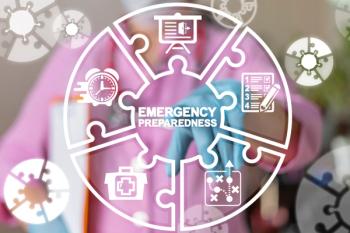
- Psychiatric Times Vol 36, Issue 8
- Volume 36
- Issue 8
Hospital-Based Psychiatric Emergency Programs: The Missing Link for Mental Health Systems
This article, the first of a three-part series, describes how hospital-based psychiatric EDs differ from community-based crisis centers.
Boarding of psychiatric patients in medical emergency departments (EDs) for hours or even days is a serious issue plaguing hospitals across the country. Typically, the emergency physician has determined that the patient needs further psychiatric care. However, the sole option available is usually admission to an inpatient psychiatric facility.
Unfortunately, few regions have enough inpatient psychiatric beds to meet the needs of a system predicated on admitting the majority of ED patients, especially since, in the past decade, behavioral health patients have risen to become one in every eight cases in EDs in the US.1 As a result, psychiatric patients can end up confined indefinitely in small ED quarters with a sitter or security guard, or restrained to a gurney in a back hallway, while they await admission. Many of these boarded patients receive little or no psychiatric treatment beyond sedation. Thus, sadly, the most highly acute patients in a mental health system are often ironically the most underserved.
Fortunately, we now have an evidence-based solution that can fill this glaring gap in the psychiatric care continuum: hospital-based psychiatric EDs. These timely, compassionate, trauma-informed, and cost-effective programs have the potential to not only dramatically improve treatment options, but also save behavioral health systems millions of dollars annually by stabilizing patients in the emergency setting, and thus avoiding costly inpatient admissions.
Hospital-based psychiatric EDs are also known as Psychiatric Emergency Services (PESs), Comprehensive Psychiatric Emergency Programs (CPEPs), Clinical Decision Units (CDUs) or, more recently, EmPATH Units (Emergency Psychiatry Assessment, Treatment and Healing Units). Psychiatric EDs have been shown to stabilize over 75% of high-acuity psychiatric outpatients within 24 hours.2 These units provide far faster relief from distressing mental health symptoms than traditional treatment pathways while preserving inpatient psychiatric beds for patients who truly have no alternative.
This article, the first of a three-part series, describes how hospital-based psychiatric EDs differ from community-based crisis centers. Also explored is how these centers can serve as the missing link in comprehensive behavioral health systems while complementing both inpatient and community services. The second installment will highlight innovative psychiatric ED programs around the nation and their impressive outcomes and metrics. And in the final installment, the perplexing reimbursement issues facing psychiatric EDs will be discussed with strategies to overcome them suggested.
Differentiating hospital-based psychiatric EDs from community crisis centers
Community-based crisis centers have burgeoned in recent years and have been a valuable addition to the spectrum of behavioral health services. Typically basing their approach on a Wellness and Recovery model, they can help many people through difficult life events, stressful situations, and decompensations of chronic psychiatric illnesses. Also known as drop-in or walk-in services, crisis intervention or diversion, community subacute crisis stabilization units, and psychiatric urgent care, these welcoming facilities are typically located away from hospitals-often near public services and mental health clinics.
Community crisis centers are most commonly staffed by therapists and social workers trained to counsel individuals while providing a safe and supportive environment. Psychiatrists or psychiatric nurse practitioners may also be available, though their hours are usually limited.
Most community crisis center patients self-present or are escorted voluntarily to the clinic by case managers, mobile crisis personnel, or police officers. Each patient typically receives a thorough psychosocial assessment and referrals to follow-up care. Some clinics also provide overnight crisis stabilization services.2
Yet while community-based programs provide many benefits, they are usually not equipped to care for patients with serious or dangerous psychiatric conditions. These centers commonly have a long list of exclusion criteria such as acute aggression, danger to self, involuntary status, or comorbid substance abuse disorders (Table). Both current and prospective patients who display these criteria are typically directed to hospital EDs or transported there by law enforcement or emergency medical services; indeed, many centers have required treatment algorithms for high-acuity patients that clearly end in “send to hospital emergency department or call 911.”
It is worth noting that these types of patients who would be excluded from community crisis centers likely make up a large percentage of the high-acuity individuals who end up boarding in EDs awaiting inpatient care. So, while community crisis centers can do fantastic work, they might have a negligible effect on ED utilization involving patients with high-acuity psychiatric conditions. In fact, expecting these organizations to handle the most acute psychiatric patients would be like expecting a private doctor’s office to treat heart attacks and severe car accidents.
Through no fault of their own, some community crisis centers have become victims of unrealistic expectations. State and county behavioral health leaders might assume that by creating these centers they will dramatically reduce the number of psychiatric patients presenting to EDs-and therefore put a dent in ED boarding. This is not only unfair to the centers, it also sadly underestimates how serious, debilitating, life-threatening, and unpredictable the emergency symptoms of severe mental illness can be, and how these require an elevated level of care.
This is where hospital-based psychiatric EDs fit in. Because emergency psychiatry programs are designed to work with highly acute individuals, they can typically accept the lion’s share of patients who would be excluded from community crisis centers. But rather than board patients for admission as would traditional medical EDs, hospital-based psychiatric EDs quickly assess and initiate prompt treatment, with a goal of stabilization in the emergency setting, and discharge to home or other less-restrictive levels of care rather than inpatient admission. And indeed, across many different locations and care models-rural and urban, academic and municipal-psychiatric EDs have proved very effective. The great majority of psychiatric ED patients in programs around the country, typically 70% to 80% or even higher, successfully stabilize and return home or to outpatient dispositions in less than 24 hours.3
Treating high-acuity patients in psychiatric EDs rather than boarding them in general EDs just makes sense. Psychiatric cases are the only class of patients seen in EDs for whom the default treatment plan has traditionally been inpatient admission. An ED would not, for example, hold a patient having an asthma attack for transfer to an “inpatient asthma bed”; instead, they would treat the patient’s breathing difficulties as soon as possible. Psychiatric emergency patients are also experiencing urgent distress and deserve that same rapid approach.
Initiating prompt emergency care is exactly what the psychiatric EDs do. This is also completely consistent with the federal Emergency Medical Treatment and Labor Act (EMTALA) governing hospitals that considers high-acuity psychiatric emergencies to be equivalent legally to medical emergencies, deserving the same immediate attempts to evaluate and stabilize. Meanwhile, patients who may benefit most from community crisis centers might be unlikely to require the high-acuity approach of the emergency psychiatry sites and would perhaps be reluctant to go to hospital EDs in the first place-so these programs can optimally work together in an almost completely complementary way, which would rarely be redundant.
One historic distinction has been the idea that hospitals use the medical model while community crisis centers are more wellness and recovery focused, but this does not have to be the case when a hospital-based psychiatric emergency program is part of the system. Many psychiatric EDs-particularly newer designs like EmPATH Units-blend the wellness and recovery model with the medical model, hoping to bring the best of both approaches, where appropriate, to the unique challenges of high-acuity patients. The result is a supportive, calming, and homelike environment where patients can also receive the specialized medical attention and intervention needed. There is thus potential for a seamless continuity of care philosophy connecting hospital-based psychiatric EDs and community crisis clinics.
It is clear that to provide every patient experiencing acute psychiatric symptoms with timely, individualized, and an appropriate level of care, and to minimize ED boarding, mental health systems should endeavor to support both community crisis centers and hospital-based psychiatric EDs.
Disclosures:
Dr Zeller is Vice President for Acute Psychiatry with the physician partnership Vituity and Assistant Clinical Professor of Psychiatry, University of California, Riverside, CA. He is an Editorial Board Member of Psychiatric Times.
References:
1. Santillanes G, Lam CN, Axeen S, Menchine MD. 45 trends in emergency department mental health visits from 2009-2015. Annals Emerg Med. 2018;72:S21.
2. Zeller S, Calma N, Stone A. Effects of a dedicated regional psychiatric emergency service on boarding of psychiatric patients in area emergency departments. West J Emerg Med. 2014;15:1-6.
3. National Council 2015 Crisis Services Survey.
Articles in this issue
over 6 years ago
Children Who Ask to Become Suicide Bombersover 6 years ago
The Passing of a Matriarchover 6 years ago
Caffeine: Neurobiological and Psychiatric Implicationsover 6 years ago
Making Your Practice Work for Youover 6 years ago
Polypharmacy: A Challenge for Community Psychiatristsover 6 years ago
Opioid Use in Pregnancy Affects Offspring Across Childhoodover 6 years ago
Psychiatrists: The Luckiest People on Earth?over 6 years ago
All the World’s NotesNewsletter
Receive trusted psychiatric news, expert analysis, and clinical insights — subscribe today to support your practice and your patients.















